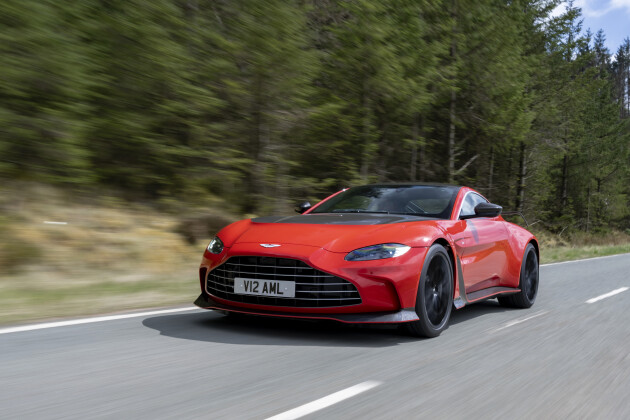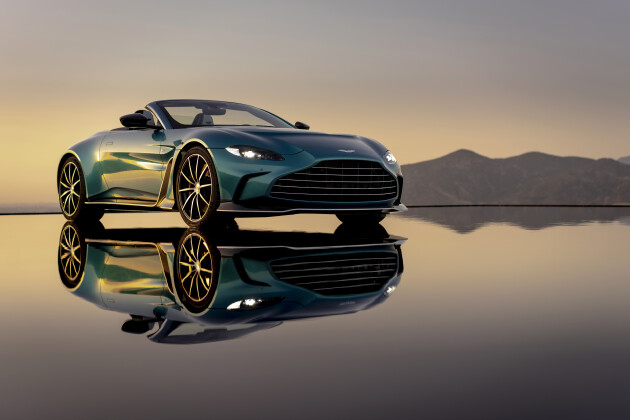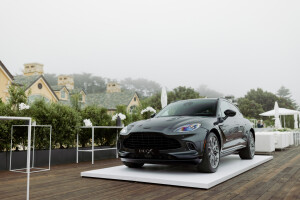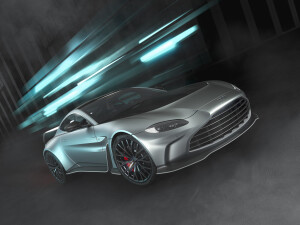Latest Review

2022 Aston Martin V12 Vantage review: International first drive
Former AMG boss Tobias Moers’ tenure as Aston Martin CEO may have been brief, but the staggering V12 Vantage is his legacy
The new Aston Martin V12 Vantage was never part of the plan. The current Vantage, unveiled in late 2017, was always intended to be powered by Aston-tweaked versions of the versatile Mercedes-AMG 4.0-litre twin-turbo V8.
Former AMG boss Tobias Moers’ tenure as Aston Martin CEO may have been brief, but one of the things he did while in the job was to rip up the plan. The V12 Vantage is his car. And this staggeringly fast Aston Martin is a fitting legacy.
The starter motor spins with that curious keening whirr you only get with a V12 before the 5.2-litre twin-turbo engine fires up and settles down to a brisk metallic idle that betrays an edgy intensity under the bonnet.
As well it might: Though it doesn’t boast quite the ultimate muscle of the version in the big and beautiful DBS Superleggera, the V12 in the Vantage pumps out a healthy 515kW at 6500rpm and 753Nm of torque from 1800rpm to 6000rpm.
Stuff a big engine into a small car – it’s a performance formula that’s worked for more than a century. The V12 Vantage is more than just a simple engine swap, though.
To ensure the suspension has the best possible platform to work with, overall body stiffness has been increased with additional front and rear shear panels, a rear suspension tower strut brace and fuel tank bracing. Suspension changes include new adaptive dampers, revised bushing and stiffer front top mounts.
The track has been widened 41mm, and spring rates have been increased by 50 per cent at the front and 40 per cent at the rear, while the front stabiliser bar is five per cent stiffer. The rear stabiliser bar is 41 per cent softer, and an additional spring with a lower rate than the main spring has been added to ensure ride comfort without compromising dynamic performance.
Standard wheels are 21-inch alloys in two new designs, each available in satin black with diamond-turned highlights, or simply satin black, with a lightweight wheel available as an option. Standard tyres are Michelin Pilot 4S, 275/35 R21 at the front and 315/30 R21 at the rear.
Twelve cylinders and two turbochargers generate a lot of heat in an engine compartment originally intended for a V8. That explains the full-width, rear-facing vent on the redesigned bonnet, the redesigned front bumper framing a 25 per cent larger grille and the larger vents in the redesigned front guards.
Visual changes over other Vantages also include large, single-piece side sills extending from the side vents, a new rear bumper with an integrated diffuser, and central twin exhaust outlets.
The dramatic rear wing, whose softly contoured form echoes that of the rear wing on the Aston Martin AMR22 F1 car, isn’t just there to impress your mates; it’s been designed to work with the new front splitter to generate more than 200kg of downforce at the car’s 320km/h top speed.
Much of the interior is shared with the V8 Vantage and is highly customisable. The woven leather or Alcantara seat inserts, trim inlays and the anodised rotary dials found in the centre console can be configured to match or contrast with the exterior body or graphic colour.
Optional lightweight sports seats with exposed carbon-fibre shells are unique to the V12 Vantage, however. Unless you are snake-hipped and limber, don’t bother with them; clambering over those hard edges is bruising.
The big V12, designed and engineered in-house at Aston Martin to power the DB11 coupe launched in 2016, almost fills the Vantage’s engine bay. Almost. Less than 50mm of the engine, which weighs significantly more than the V8, extends over the front axle centre line, which explains why the front to rear weight distribution has shifted only marginally from the V8 Vantage’s perfect 50:50 to 52:48.
Aston’s engineers haven’t just relied on the V12’s abundance of power and torque to deliver improved performance over the V8 Vantage. Weight-saving measures include standard 410mm front and 360mm rear carbon-ceramic brakes that remove 23kg of unsprung mass, a stainless steel exhaust that’s 7.2kg lighter than the regular Vantage system, and carbonfibre bonnet, front guards, bootlid and front and rear bumpers. The optional forged alloy wheels save a further 8kg.
The 393kW Vantage F1 Edition was, until now, the most powerful car in the current Vantage line-up. The V12 Vantage has pretty much a whole Toyota Corolla’s worth of extra grunt under the bonnet – 122kW extra, to be precise. That means that despite weighing 216kg more, it has a 20 per cent better power to weight ratio. And you can feel it, though not quite in the way you might expect.
Next to the growling gut-punch you get from the F1 edition’s V8 at what seems little more than idle speeds, the V12 Vantage’s engine feels curiously languid at first, even though its 68Nm greater peak torque is being produced from 200rpm lower in the rev band.
It’s perception rather than reality, amplified by the different power and torque characteristics of the two engines. V12s, even turbocharged ones, like to rev. While the torque output of the F1 Edition’s V8 begins to taper after 5000rpm and its power peak comes at 6000rpm, the V12 holds on to its maximum torque until 6000rpm and makes its peak power at 6500rpm.
There’s a touch of turbo lag if you punch the throttle hard below 2000rpm, but once everything’s spooled up, the acceleration shoves you hard back into the seat. Aston claims a 0-100km/h acceleration time of 3.5 seconds, making it the quickest-accelerating Vantage ever.
The massive thrust from 3000rpm to 6000rpm means the V12 Vantage is astoundingly fast on any road, compressing time and space between corners as only a car with more than 500kW can.
Yet, this is no hardcore, racer’s edge experience like, say, a Porsche 911 GT2 RS; there’s a velvety edge to the V12’s snarl and surprising compliance to the ride, even with the suspension in the stiffest of its three settings, that makes it feel almost like a gran turismo. A gran turismo on steroids.
It’s fast on the track, too, even on road-optimised tyres. The mechanical limited-slip differential deftly funnels all that power and torque to the tarmac the instant you want more.
Those giant carbon-ceramic brakes deliver unquenchable stopping power as the corners rush towards you, and the front end responds to the meaty steering with impressive calmness and authority, despite the extra weight over the front axle.
There aren’t too many 515kW rear-drive road cars in which you can confidently switch off the traction and stability controls on a track after only a handful of laps, but the V12 Vantage is one of them.
Yes, there’s power enough to smoke the rear tyres almost any time you want. But the sensitivity of the throttle and the clarity of the feedback through the chassis is such that you can feel exactly where the limits of adhesion are and modulate your inputs accordingly.
Will it drift? Of course. But what makes the V12 Vantage so much fun on the track is that you can drift it more like Sebastian Vettel than Ken Block, more subtly and with much higher absolute corner speeds.
It’s an easy car to drive fast, this Aston, but it’s not just because of the power. Confidence comes from a chassis that’s fundamentally well-sorted rather than constantly slapped into line by an assortment of electronic nannies.
Track time exposes the one weak link in the V12 Vantage’s performance arsenal, however: The eight-speed automatic transmission. As automatics go, the ZF eight-speed used by Aston Martin is a benchmark, but when you start to push the V12 Vantage, the upshifts feel laggardly and the downshifts woolly, even in Track Mode. It only takes a couple of laps to understand that mighty V12 demands the crisp precision of a dual-clutch transmission.
Aston Martin is building just 333 V12 Vantages. And every single one is already sold, despite a price tag that starts north of half a million bucks.
That’s because the 2023 V12 Vantage is destined to be a classic Aston Martin. There won’t be another small Aston with a V12 under the bonnet, and the engine itself is unlikely to stay in production beyond 2026 or 2027.
Nice way to say goodbye, Tobias.
News
-
 News
NewsAston Martin unveils 515kW V12 Vantage Roadster
British carmaker lifts the lid on most powerful Vantage roadster ever
-
 News
NewsAston Martin to debut two new models at Pebble Beach
The company will showcase two new models alongside the DBX707 and Valhalla
-
 News
News2022 Aston Martin V12 Vantage revealed, limited to 333 units
The final-ever V12 Vantage packs a big punch – but it’ll be limited to 333 units, which have already sold out
-
 News
News2022 Aston Martin V12 Vantage reveal date set
New Vantage will be a V12 swansong before electrification strategy kicks in
-

Aston Martin teases return of the V12 Vantage for a Final Edition farewell
-

Aston Martin ‘V600’ badge revived for Vantage

